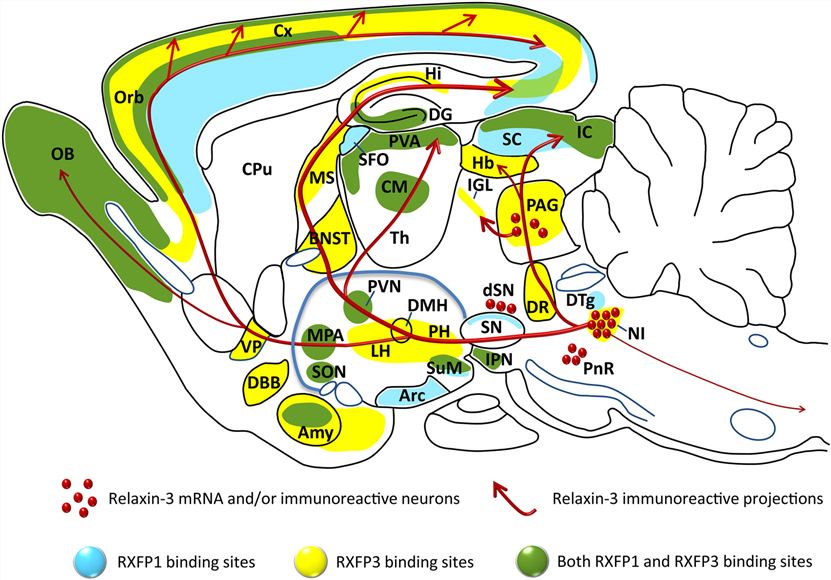Introduction of RXFP3
Relaxin-3 Receptor 1 (RXFP3) is encoded by the RXFP3 gene. It belongs to the G-protein-coupled receptor (GPCR) family which has been extensively studied during the past few decades because it offers numerous possibilities for therapeutic applications. Relaxin is a hormone which was first discovered to play a role in pregnancy. Recent researches found that it is also a cardiovascular protector. Studies have identified four receptors that are the physiological targets for relaxin family peptides. They are therefore named RXFP1-4 (relaxin family peptide receptors1-4). RXFP3 belongs to type 1 small peptide receptors and its structural feature is a relatively short N-terminal domain.
| Basic Information of RXFP3 | |
| Protein Name | Relaxin-3 receptor 1 |
| Gene Name | RXFP3 |
| Aliases | RLN3R1, SALPR, GPCR135 |
| Organism | Homo sapiens (Human) |
| UniProt ID | Q9NSD7 |
| Transmembrane Times | 7 |
| Length (aa) | 469 |
| Sequence |
MQMADAATIATMNKAAGGDKLAELFSLVPDLLEAANTSGNASLQLPDLWWELGLELPDGAPPGHPPGSGGA ESADTEARVRILISVVYWVVCALGLAGNLLVLYLMKSMQGWRKSSINLFVTNLALTDFQFVLTLPFWAVE NALDFKWPFGKAMCKIVSMVTSMNMYASVFFLTAMSVTRYHSVASALKSHRTRGHGRGDCCGRSLGDSCC FSAKALCVWIWALAALASLPSAIFSTTVKVMGEELCLVRFPDKLLGRDRQFWLGLYHSQKVLLGFVLPLG IIILCYLLLVRFIADRRAAGTKGGAAVAGGRPTGASARRLSKVTKSVTIVVLSFFLCWLPNQALTTWSIL IKFNAVPFSQEYFLCQVYAFPVSVCLAHSNSCLNPVLYCLVRREFRKALKSLLWRIASPSITS MRPFTATTKPEHEDQGLQAPAPPHAAAEPDLLYYPPGVVVYSGGRYDLLPSSSAY |
Function of RXFP3 Membrane Protein
RXFP3 is a receptor for RNL3/relaxin-3. Binding of the ligand inhibits cAMP accumulation. The main ligand of RXFP3 is relaxin-3. The current study considers that Relaxin-3 is a neurohormone and the relaxin-3-RXFP3 system mainly plays a regulatory role in the central nervous system and it participates in the regulation of response, maintenance of arousal and cognitive function. Besides, cell signaling events associated with the relaxin-family receptors have been researched in different cell lines transfected with the human receptors and activation of RXFP1 and RXFP3/4 by H3 relaxin results in different intracellular responses in vitro. It has reported that in CHO cells, RXFP3 and RXFP4 couple to the inhibitory Gαi/Gαo-protein system and receptor activation results in sequestration of these G-proteins and inhibition of adenylate cyclase (AC), and subsequent cAMP accumulation.
 Fig.1 Distribution of the relaxin-3 neural network and RXFP3 in relation to RXFP1, illustrated on a schematic parasagittal profile of the rodent brain.
Fig.1 Distribution of the relaxin-3 neural network and RXFP3 in relation to RXFP1, illustrated on a schematic parasagittal profile of the rodent brain.
Application of RXFP3 Membrane Protein in Literature
This article reports that the distribution of RLN3/RXFP3 networks in rat brain and recent experimental studies suggest a role for this system in modulation of arousal, stress, metabolism, and cognition.
This article reveals that neuroanatomical colocalization of GPCR135 and relaxin-3, coupled with a clear high-affinity interaction, suggest that GPCR135 is the receptor for relaxin-3.
This study demonstrates that the A-chains among some of the insulin/relaxin family members are pharmacologically exchangeable.
The results of this experiment provide new insights into the action of relaxing and demonstrate that the role of the A-chain for relaxin activity is both peptide- and receptor-dependent.
RXFP3 Preparation Options
To obtain the soluble and functional target protein, the versatile Magic™ membrane protein production platform in Creative Biolabs enables many flexible options, from which you can always find a better match for your particular project. Aided by our versatile Magic™ anti-membrane protein antibody discovery platform, we also provide customized anti-RXFP3 antibody development services.
As a forward-looking research institute as well as a leading customer service provider in the field of membrane protein, Creative Biolabs has won good reputation among our worldwide customers for successfully accomplishing numerous challenging projects including generation of many functional membrane proteins. Please feel free to contact us for more information.
All listed services and products are For Research Use Only. Do Not use in any diagnostic or therapeutic applications.